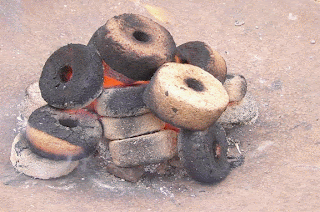Differing waste materials have different energy contents. If you are working with commercial or export markets, they may want to know the energy contents of the briquettes. For those markets, you may want to know the energy content of the materials you are briquetting.
Kikumu agriculture research centre shall briquette waste disposals to ensure that landfills in urban and gab badge disposals are used properly by man
Requires the following considerations:
The difficulty of firewood access and other sources for cooking energy sources
If firewood is difficult to access, then conduct a briquettes production project. If cheap,
there is no need.
The local policies related to fuel wood consumption
Get an overview on policies in favor of or against collection of firewood.
The limitations to using alternative fuels and restrictions on marketing
Find space in the market
Can charcoal sellers be integrated?
The proximity to the local market for sale of fuel briquettes
If demand is there, pool resources together and transport the fuel briquettes
The experience of the group with entrepreneurial self-reliance and sustainable activity
Group must be innovative, interested, and creative in order to survive
Make briquettes production a business, not an activity
The availability and applicability of published baseline information on fuel wood/rural energy
consumption for eventual impact assessment of the project/enterprise
Key data: Population size, household sizes and expenditure on cooking fuel (e.g.
kerosene, charcoal and similar); electricity, gas (LPG), rate of deforestation and plans for
reforestation, and types of woodlots
The availability of water supplies
200-300 liters of water are needed daily for commercial fuel briquettes making
10 liters of clean drinking water for producers (daily)
Trap and recycle used water during fuel briquettes pressing process
Whether there is sufficient space for the production activity
Enough space, room or ground is needed
Storage space must be dry and well aerated
Space for decomposing a good number of rows of raw materials
Whether there are sufficient resources for production
Raw materials for fuel briquettes production
- Funds
- Time
- Hot weather
- Human labor
- Equipment (e.g. press machine and chopper/thresher)
The commitment of the group/trainees
- Preparedness to source materials, invest their time and energy
- Regular production
- Self-monitoring and evaluation
- Consultations and meet consultancy expenses
- Assess financial feasibility during this first visit
SECOND SITE VISIT (Length: 1 Day)
Involves a full day of meetings in order to:
Refine the Selection Process of Trainees to ensure success of the activity, and ascertain whether
trainees are ready and willing. Find out if:
- There are interested groups; venue is available and any deterrent factor?
- The community is aware of alternative sources of cooking energy?
- Any perception of wood fuel availability and environmental impact?
- There are any other suggestions
- Demonstrate Fuel Briquettes Making and Cooking
Briquette Making
Successful demonstration needs:
§ Equipment for briquetting
§ Raw materials (readily decomposed)
§ Water
§ Labor
Cooking Demonstration
Involves:
§ Stoves
§ Food to be cooked
§ Some dry briquettes
§ Eating the cooked food
§ Allaying any fears
§ Grasping briquettes lighting and replacement during burning process
§ Comments from trainees
Decomposing
- Use usual decomposing procedures but do not add soil
- The material should not decompose into compost fertilizer, about 4 weeks maximum
- Make successive heaps of 50cm high x 1metre wide x 5metres long rows to avoid
- missing what to briquette
- Dry decomposed material and store safely to save pounding time and trouble
- • Mixing/Blending the Materials after Decomposing
- Suitably decomposed material can be blended
- Pound in mortar, adding water in bits
- Conduct three hand tests which apply to materials that require chopping/milling:
§ Ooze test – Scoop some materials into your fist then squeeze; if it oozes through
your fingers, it is too ripe
§ Spring back test – If the material expands when squeezed in your hand, it is not
ready
§ Shake test – Material well decomposed, when squeezed in your hand and then
shaken vertically, never falls apart
The Press and Briquette Making
Prepare material for press making using available measurements from the trainer
§ The press machine compresses fuel briquettes into uniform shapes and sizes
better than bare hands
o When decomposed material is ready, start fuel briquetting. Let different groups produce
different blends
Six people can produce 750 –1000 fuel briquettes per 8 hrs, daily
§ Holey briquettes dry faster and burn effectively
Follow procedures for quality fuel briquettes making (e.g., right blending and ingredients
measure, pressing, drying, storage, protection from wetness, etc.)
Handle wet fuel briquettes with care and dry them in direct hot sun for 3–6 days,
electricity/solar dryer or in a dark well-aerated place – but this takes time
Press Maintenance
- Ensure care to lengthen its lifespan
- Do not dry it in the sun to avoid cracking
- Preserve it with waterproof paints
- Oil or grease the nuts
- Keep under shade or cover it when not in use

No comments:
Post a Comment